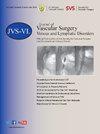The role of venoactive compounds in the treatment of chronic venous disease
IF 2.8
2区 医学
Q2 PERIPHERAL VASCULAR DISEASE
Journal of vascular surgery. Venous and lymphatic disorders
Pub Date : 2025-05-08
DOI:10.1016/j.jvsv.2025.102258
引用次数: 0
Abstract
Background
Chronic venous disease (CVD) is a major global health issue, affecting millions of people and contributing to significant morbidity and economic strain. The condition's pathophysiology is complex, involving both mechanical and biochemical processes that lead to venous reflux, obstruction, and chronic inflammation. This review focuses on the role of venoactive compounds (VACs), also known as venoactive drugs in Europe and other parts of the world, in managing CVD. The aim was to review the scientific evidence and to define the role of VACs within the comprehensive treatment algorithm for CVD, alongside established and well adopted interventional therapies and noninterventional therapies such as compression.
Methods
The review of the scientific evidence was done on VACs mechanism of action and efficacy in alleviating CVD symptoms, reducing swelling or venous edema, and improving healing of venous leg ulcers. Whenever available, systematic reviews, meta-analyses and randomized controlled trials were used. The quality of evidence assessment followed the GRADE methodology from A (high), B (moderate), to C (low to very low) quality.
Results
Venoactive drugs or compounds share similar effects, such as sealing the endothelial barrier, enhancing lymphatic drainage, reducing edema, improving venous tone, inhibiting leukocyte adhesion to vein walls/valves and inflammatory mediator release, lowering blood viscosity, and promoting red blood cell flexibility. Scientific evidence on the VACs effectiveness on CVD symptoms (pain, cramps, and heaviness) and swelling or edema have shown some variability. Micronized purified flavonoid fraction (MPFF) and Ruscus extract combined with hesperidin methyl chalcone and ascorbic acid had the highest, mostly level A, quality of evidence. In venous leg ulcers, micronized purified flavonoid fraction, sulodexide, and pentoxifylline were the most effective adjunctive treatments, with evidence level A.
Conclusions
The existing scientific evidence provides a strong rationale for incorporating VACs into a comprehensive treatment plan for CVD, alongside established interventional therapies and noninterventional approaches like compression, to optimize patient outcomes and improve quality of life.
静脉活性化合物在慢性静脉疾病治疗中的作用。
慢性静脉疾病(CVD)是一个主要的全球健康问题,影响着数百万人,并造成了显著的发病率和经济压力。这种疾病的病理生理是复杂的,包括导致静脉回流、阻塞和慢性炎症的机械和生化过程。目的:本综述将重点介绍静脉活性化合物(VACs),在欧洲和世界其他地区也被称为静脉活性药物,在心血管疾病治疗中的作用。目的是回顾科学证据,并确定VACs在心血管疾病综合治疗算法中的作用,以及已建立和广泛采用的介入治疗和非介入治疗(如压迫)。方法:对VACs在缓解CVD症状、减轻肿胀或静脉水肿、促进下肢静脉性溃疡愈合方面的作用机制和疗效进行科学综述。只要有可能,就采用系统评价、荟萃分析和随机对照试验。证据质量评估采用推荐、评估、发展和评价分级(GRADE)方法,A =高,B =中等,C =低至极低质量。结果:静脉活性药物或化合物具有相似的作用,如封闭内皮屏障,增强淋巴引流,减少水肿,改善静脉张力,抑制白细胞粘附静脉壁/瓣膜和炎症介质释放,降低血液粘度,促进红细胞柔韧性。关于VACs对CVD症状(疼痛、痉挛、沉重)和肿胀或水肿的有效性的科学证据显示出一些差异。微粉化纯化的黄酮类成分(MPFF)和ruscus提取物与橙皮苷、甲基查尔酮和抗坏血酸联合使用的证据质量最高,大部分为A级。在下肢静脉性溃疡MPFF中,舒洛地特和己酮茶碱是最有效的辅助治疗,证据水平为a。结论:现有的科学证据为将VACs纳入CVD的综合治疗计划提供了强有力的理论依据,并与已建立的介入治疗和非介入方法(如压迫)一起,优化患者预后并改善生活质量。
本文章由计算机程序翻译,如有差异,请以英文原文为准。
求助全文
约1分钟内获得全文
求助全文
来源期刊

Journal of vascular surgery. Venous and lymphatic disorders
SURGERYPERIPHERAL VASCULAR DISEASE&n-PERIPHERAL VASCULAR DISEASE
CiteScore
6.30
自引率
18.80%
发文量
328
审稿时长
71 days
期刊介绍:
Journal of Vascular Surgery: Venous and Lymphatic Disorders is one of a series of specialist journals launched by the Journal of Vascular Surgery. It aims to be the premier international Journal of medical, endovascular and surgical management of venous and lymphatic disorders. It publishes high quality clinical, research, case reports, techniques, and practice manuscripts related to all aspects of venous and lymphatic disorders, including malformations and wound care, with an emphasis on the practicing clinician. The journal seeks to provide novel and timely information to vascular surgeons, interventionalists, phlebologists, wound care specialists, and allied health professionals who treat patients presenting with vascular and lymphatic disorders. As the official publication of The Society for Vascular Surgery and the American Venous Forum, the Journal will publish, after peer review, selected papers presented at the annual meeting of these organizations and affiliated vascular societies, as well as original articles from members and non-members.
 求助内容:
求助内容: 应助结果提醒方式:
应助结果提醒方式:


